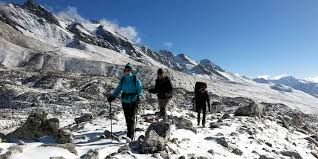Everest base camp trek is one of the famous trek rout and adventure activity to do. this guide is for solo traveler or adventure lover who wants to add extra thrilling experience in their life.
Getting to the foot of Everest may be one of the amazing experiences one can have but only when taken proper measures and by making wise decisions. One doesn’t really need to fear it or avoid it due to its challenging nature but prepare for every possible thing that may happen.
The major attraction of Everest Base Camp Trek is getting at the Base Camp itself but also climbing up to Kalapatthar where you can get the best view, Everest. There can be many reasons for this trek, thrill, adventure, outstanding views, communion with nature, exploring isolated culture, feeling of achievement or combination of many.

Altitude Gain
This trek usually starts from Kathmandu at the elevation of 1345 meters and takes you to Lukla airport at 2860 meters. The altitude gradually increases as you trek towards the Base Camp. It is necessary to give your body some time to adjust with the increasing elevation and decreasing available Oxygen so acclimatization is necessary. After getting at an altitude higher than 3000 meters at Namche, it is highly advised to spend yet another day there. Again at Dingboche, crossing an altitude of 4000 meters, it is highly necessary to spend another day acclimatizing. As altitude gets higher and higher, the trek should be progressed slowly and steadily.
The highest point get during this trek it Kalapatthar at 5550 meters and highest altitude you will stay at is Gorakshep at 5140 meters. Any slight signs of altitude sickness should be enough to tell you to take it slow else you may get to the point of quitting the trek.
Temperature
Summer is the best time for anyone who is not ready to be in cold temperatures as the minimum temperature is 0 °C while in winter it may get up to -20 °C at night but days are clear and sunny. Autumn is the peak season of this trek due to a comfortable temperature during days and nights with a slight chance of rain. Spring is the best time for viewing Rhododendron forest along the trek blooming in beautiful flowers. No matter which season you travel, it is suggested that you bring a down jacket and a waterproof and windproof jacket.
Trekking Route
Traditional Everest Base Camp trek takes you to Everest Base Camp through Lukla to Namche to Tengboche to Dingboche to Lobuche to Gorakshep to EBC route while there are alternative routes through Pheriche-Phortse which can be taken while returning and some trekkers chose to extend this trek with Kalapatthar, one or more high passes and/or Gokyo lakes. Kala Patthar is the viewpoint to capture a perfect shot of the Everest and other peaks so most of the trekkers go there after reaching Everest Base Camp.
Trekking Terrain and Physical Preparation
A normal day in Everest Base Camp trek includes uphill and downhill climbing for more than 5 hours. Some part for this trekking itinerary demands more hours of trekking or some difficult terrain. This kind of trekking for about 2 weeks is physically demanding. So, physical exercises prior to the trek that focuses on endurance and leg strength are very recommended. Especially for those who have never gone multi-day trekking. Make sure you break in your new trekking boots before the trek.
Food and Accommodation
Trekking in rural parts of Nepal means living a simple life with simple food and minimum luxuries. Tea houses provide clean and comfortable beds and accommodation is cheap. They provide nice and simple food but are a bit expensive due to the difficulty locals face bringing goods to such an isolated place. During peak seasons and approaching the Everest Base Camp, the number of options will be less. Traveling with a guide or booking a package takes away the stress of getting a nice accommodation every day. It is suggested that you bring Choco bars, energy bars, etc. from Kathmandu.
Cost
Traveling on your own saves you some money as you don’t have to tip the guides, pay for the package. Things that you need to pay for are plane tickets to/from Lukla costing $150 each way, permits like TIMS card (get it while in Kathmandu) and Sagarmatha National Park Permit (get it on Monjo) costing around $60, food and accommodation costing around $50 per day, personal items and anything else you may need or want during the trek like mineral water.
Without a Guide
Though this trek is possible even without a guide, it is highly recommended for anyone trekking in Nepal Himalayas for the first time or for someone who is new to trekking. Traveling with someone who has already been there several times can suggest what is best at a certain place or time. A local guide can also help you communicate with indigenous people. Traveling alone means a lot of research before the trek and many trials and errors along the trek. If that means adventure to you, go for it!





